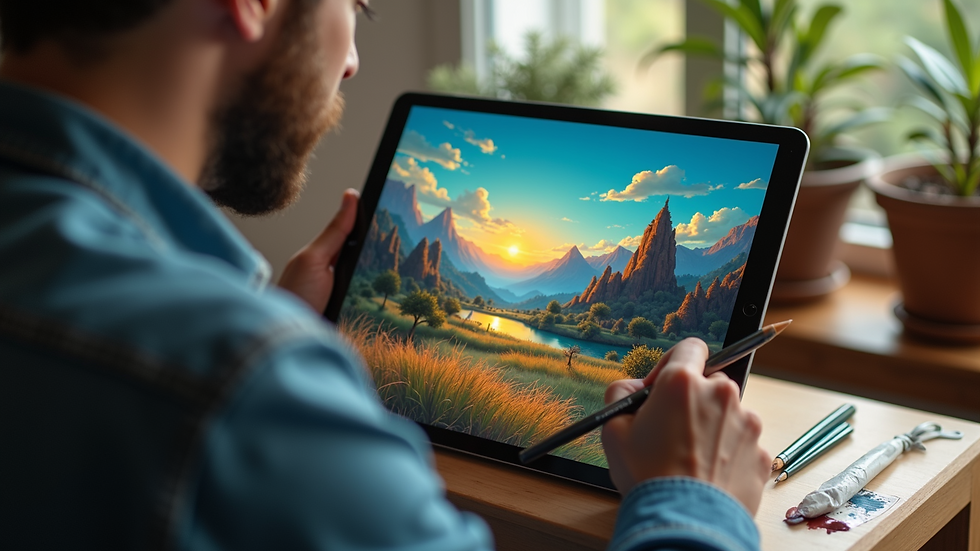Exploring Digital Art Techniques: A Visual Arts Class Showcase
- Joaquin Escalante
- Aug 8
- 4 min read
Digital art has transformed the way we create and appreciate art. With the rise of technology, artists now have access to a variety of tools and techniques that allow them to express their creativity in new and exciting ways. In this blog post, we will explore some of the most popular digital art techniques showcased in a recent visual arts class. Whether you are a beginner or an experienced artist, these techniques can inspire you to create your own digital masterpieces.
Understanding Digital Art
Digital art refers to any artwork created using digital technology. This can include illustrations, paintings, animations, and even 3D models. The beauty of digital art lies in its versatility. Artists can experiment with different styles and techniques without the limitations of traditional mediums.
The Tools of the Trade
To create digital art, artists typically use software and hardware designed for this purpose. Some of the most popular tools include:
Graphic Tablets: These devices allow artists to draw directly onto a screen, providing a natural drawing experience.
Digital Painting Software: Programs like Adobe Photoshop, Corel Painter, and Procreate offer a wide range of brushes and tools for creating stunning digital paintings.
3D Modeling Software: Applications like Blender and ZBrush enable artists to create three-dimensional models and animations.
Techniques to Explore
In our visual arts class, students experimented with various digital art techniques. Here are some of the standout methods they used:
1. Digital Painting
Digital painting is one of the most popular techniques in the digital art world. It mimics traditional painting methods but uses digital tools. Artists can create stunning landscapes, portraits, and abstract pieces with just a few clicks.
Example: One student created a vibrant sunset scene using a combination of soft brushes and layering techniques. The result was a breathtaking image that captured the beauty of nature.
2. Vector Art
Vector art is created using mathematical equations, allowing for clean lines and scalable images. This technique is often used for illustrations, logos, and graphic design.
Example: A student designed a colorful character using vector software. The character was sharp and clear, making it perfect for use in animations or print.
3. Photo Manipulation
Photo manipulation involves altering photographs to create surreal or artistic images. This technique can include combining multiple images, adjusting colors, and adding effects.
Example: One student took a simple landscape photo and transformed it into a dreamlike scene by adding whimsical elements and adjusting the color palette.
4. 3D Modeling
3D modeling allows artists to create three-dimensional objects and environments. This technique is widely used in video games, movies, and virtual reality.
Example: A student created a detailed 3D model of a futuristic city. The model included buildings, vehicles, and even animated elements, showcasing the potential of 3D art.
5. Animation
Animation brings digital art to life. Artists can create moving images using various techniques, from traditional frame-by-frame animation to modern digital methods.
Example: One student animated a short clip featuring a dancing character. The smooth movements and vibrant colors made the animation captivating and fun to watch.
The Importance of Practice
Like any skill, mastering digital art techniques requires practice. Students in our class were encouraged to experiment and push their boundaries. Here are some tips for improving your digital art skills:
Set Aside Time: Dedicate regular time to practice your art. Consistency is key to improvement.
Seek Feedback: Share your work with others and ask for constructive criticism. This can help you identify areas for growth.
Explore Tutorials: There are countless online tutorials available for free. Use these resources to learn new techniques and expand your knowledge.
Showcasing Student Work
The visual arts class recently held an exhibition to showcase the students' digital art projects. The event was a great success, with attendees marveling at the creativity and talent on display.

Each student had the opportunity to present their work and discuss the techniques they used. This not only boosted their confidence but also fostered a sense of community among the artists.
The Future of Digital Art
As technology continues to evolve, so does the world of digital art. New tools and techniques are constantly emerging, providing artists with even more ways to express themselves.
Embracing New Technologies
Artists are now exploring the use of virtual reality (VR) and augmented reality (AR) in their work. These technologies allow for immersive experiences that engage viewers in unique ways.
Example: Some artists are creating VR installations that allow viewers to step inside their artwork, experiencing it from a new perspective.
The Role of Social Media
Social media platforms have become essential for artists to share their work and connect with audiences. Websites like Instagram and TikTok allow artists to showcase their process and gain followers.
Example: Many artists use time-lapse videos to show their creative process, attracting viewers and potential clients.
Final Thoughts
Digital art is an exciting and ever-evolving field. The techniques explored in our visual arts class demonstrate the endless possibilities for creativity. Whether you are a beginner or an experienced artist, there is always something new to learn and explore.
As you embark on your digital art journey, remember to practice regularly, seek feedback, and embrace new technologies. The world of digital art is waiting for you to make your mark. So grab your tools, unleash your creativity, and start creating today!


Comments